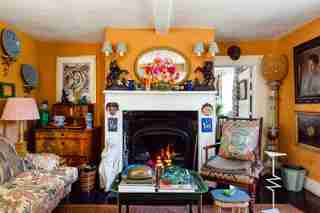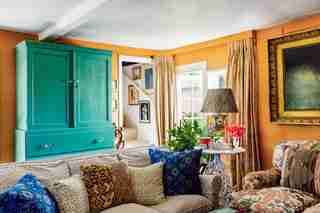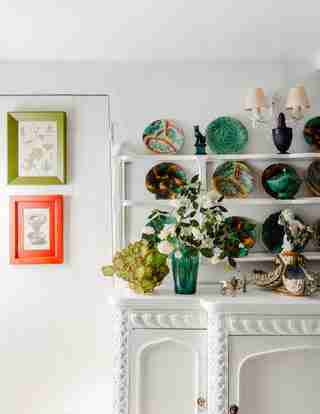As country idylls go, a pretty pink cottage down a quiet lane with a river running past it, bathed (at least when we visit) in the golden light of a late summer day, has to be about as charming as it gets. Situated in the Dedham Vale of Eastern England (where the light and the water make a reference to ‘Constable country’ an absolute necessity), this is the home of Benedict Foley, a decorator, art dealer and designer of frames, and Daniel Slowik, who recently set up his own eponymous interior design practice after 20 years at Sibyl Colefax & John Fowler .
Benedict and Daniel moved into the cottage six years ago, renting it from its owners who still live nearby. Originally intended as a weekend place, it has increasingly become their main residence since the beginning of the pandemic. The appeal of the house was in its state of preservation; it was more or less unmodernized and free from the plague of smartening up. “This is the kind of house I grew up in,” explains Daniel. “It’s what we’re used to.” The house was built in 1804, using recycled timbers from an older mill nearby, and the last renovations were made in 1969; it is still an endearingly eccentric space. The ground floor houses the only bathroom, and there are two sets of narrow stairs, one leading from the sitting room to the landing and the other from the dining room straight into the principal bedroom. Any particularly large items of furniture or artworks destined for the upper floor have to be winched in through the french doors in Benedict’s studio, which were in fact put in as a coffin window.
This is a watery landscape, and the building was indeed originally built with the river in mind. All of the original windows (which were originally doors) are at the front of the house by the road and river, since the building was originally a millworkers’ cottage, a home and workshop for twelve people, and that is where the selling of flour and loading it on passing boats would have taken place. The proximity to the river also means that the house is flooded with some regularity, so that winter days are not infrequently spent wading through a few inches of water. Benedict points out that thankfully most antique furniture is on legs, which then effectively become stilts in times of flood.
Nevertheless it is fortunate that neither of the inhabitants of the cottage are particularly precious about their stuff. And there is plenty of stuff: Both Benedict and Daniel, who specialized in antiques at Colefax, have a penchant for collecting, though it is the former who confesses to a serious addiction. The walls are filled with the pictures Benedict is constantly buying and selling, an extraordinary variety of them, from works by Ivon Hitchens and John Minton to postcards and photos in his own charming frames. The house is full of ideas for displaying art, and Benedict is nothing if not adventurous in this respect. “I enjoy what I call ‘the incidental hang,’” he explains, “where you’ve placed a picture not necessarily where other people will see it, but where you will see it as you move around the house.” And so pictures hang on the backs of doors, close to the floor, and in the lesser-seen corners of rooms.
As you might expect from an antiques expert and a self-confessed devotee of “jumbly shops,” there is little that is discernibly new in the house. What is new has often been made by friends; the unique advantage of this fact, as Benedict notes, is the opportunity to discuss the process of making with the maker themselves—something that is obviously not possibly with antiques. Evidence of Daniel’s association with Sibyl Colefax and the line of products he oversaw recurs throughout, most notably the playful “squiggle” pattern that he resurrected from the archive. When it comes to the antiques, some have been sourced from Sibyl Colefax, others were bought at auction or inherited from friends and relatives. As Benedict points out, it’s an incidentally sustainable approach. “When you buy antiques, it’s always a considered process, and you don’t end up with anything disposable.”
If collecting is one thread that leads you through the house, color is another. The light in the rooms changes dramatically throughout the day as the sun passes over, and when it fades, the strong colors on the walls ward off any suggestion of drabness. The bold yellow on the walls of the cobalt blue kitchen (a color scheme inherited from the previous inhabitants “from before the time when paint colors had names,” as Benedict remarks) and the warm ochre of Farrow & Ball’s Wet Sand in the sitting room create a sort of glow even in the dimmest light. The myriad pictures on the walls of Daniel’s bedroom stand out beautifully against an azure backdrop, while Benedict refers to the combination of violet walls and patterned fabrics in his own room as suggesting a “fabulous cross-dressing grandmother on acid.”
“How does a house come to feel so comfortable?” is one of the questions that recurs throughout our visit to the cottage. Much of the comfort surely derives from the lack of pretension and sense of humor the couple imbue it with. Although there are many genuinely beautiful things here, there is also a healthy dose of what Daniel refers to as “horror charm.” Items in this category include a gloriously Rococo wooden mirror (slightly chipped) in his bedroom, and a remarkable 18th-century object (that the Victorians would have termed a “centerpiece”) topped with a grimacing cherub (cracked) on the dresser in the dining room. “If I took this terribly seriously,” remarks Benedict, “I would probably have had it repaired. But I don’t, so I like it just as it is.” Although Daniel in particular has spent a career making things perfect for his clients, neither he nor Benedict have any inclination to perfect the cottage. To do so, they both agree, would be to detract from its charm—it’s just not that sort of place. “It’s an interesting thing to do, to fit your life to a building,” comments Benedict, “rather than to fit the building to your life. If we want to build a sustainable future, we should all be doing this more.”

Dahlias from their neighbour Veere Grenney’s garden brighten up the mantelpiece. The Spelter "Marley: horses were a present from a friend. “Normally they’re very distinguished, quite serious bronzes,” explains Benedict, “but we particularly loved these because they were the worst copies we’d ever seen, and we found that very amusing.” The cushion on the side chair is made from a fragment of Spitalfields silk, and the zig-zag side table is by Jermaine Gallacher. The room was painted in Farrow & Ball’s Wet Sand on the recommendation of their great friend Emma Burns, managing director at Sibyl Colefax & John Fowler. The sofa is covered in a Bennison chintz called Wheatberry.

At the back of the room, a simple George III linen press painted turquoise serves as a drinks cabinet, with the shelves within removed. The french doors lead into the garden.

In the dining room, the built-in dresser holds a collection of majolica pottery, with the centrepiece stealing the show in the middle. “You can date this piece by the grimace,” explains Benedict. “It was only under Queen Victoria when putti took on terribly sweet faces, whereas before that they could be much more mischievous.” The frames on the left were designed and made by Benedict for A. Prin Art.
Sibyl Colefax “Squiggle” fabric in green and white complements Colefax & Fowler’s Seaweed fabric on the tablecloth. Benedict’s favorite simple white linen napkins by Volga Linen dress the table.
Benedict and Daniel have kept the colors in the kitchen as they were under the previous occupants. As the paint has peeled off in places, they have simply glued it back on. A collection of ceramics hangs on the walls, including an early 19th-century ironstone Imari ashette (a design originally created for the Prince Regent’s Pavilion at Brighton) hanging over the oven, as well as pieces by Gavin Houghton.
Some of Benedict’s frame designs decorate the space above the dresser. These include two mirrors—prototypes Benedict has made for A. Prin Art’s May exhibition of mirrors with Jermaine Gallacher—and a pinboard, which is part of a forthcoming collaboration with Volga Linen and Alexandra Tolstoy. Two plates by the couple’s friend Gavin Houghton hang on the right and top left.
Daniel’s bedroom is painted in Farrow & Ball’s Dix Blue . The quilt is from The Tolstoy Edit.
Many of the pictures in this room, some bought by Daniel and others bought for him, relate to Venice. The lampshade is from Sibyl Colefax in the “Squiggle” pattern.
The bed has a corona made from a Swedish wallpaper border by Handtryckta Tapeter .
The landing, which is piled high with books, opens into Benedict’s bedroom. The bedroom is a riot of color and pattern, with a patchwork quilt and curtains, a deep wallpaper border, an oversized 20th-century painting and an embroidered side chair accommodating a feltwork “Whatever Happened to Baby Jane” cushion made by the artist Yve Ngoo .
The upstairs landing, which is packed with pictures. The table is a 19th-century Burmese carved table, re-lacquered by Benedict. The painting of Saint Sebastian at the end on the stairs is attributed to Otto Dix.
Outside Benedict’s bedroom, a desk is surrounded with piles of books. The blind is in Sibyl Colefax’s Venetian Blind pattern. The lamp is made out of a Han Chinese vase.
In Benedict’s studio is a chair which came from Drue Heinz’s house in Hay’s Mews, while the curtains are in Colefax and Fowler’s Tree Poppy.
Beyond the French doors in the sitting room is a small terrace perfect for outdoor entertaining. The chairs were a present from Veere Grenney and the tray is a design of Veere’s for The Lacquer Company. The coupe glasses are by Campbell Rey.
At the back of the house is another seating area.

Leave a Reply